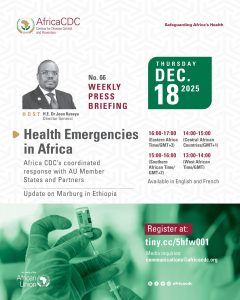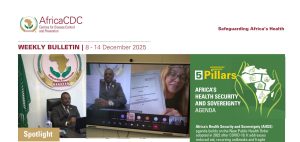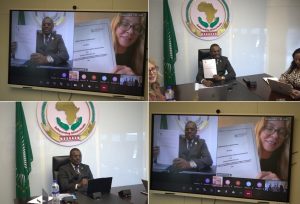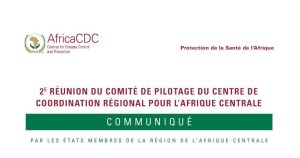Addis Ababa, Ethiopia | 7 November 2025 — A three-day continental meeting hosted at the Africa Centres for Disease Control and Prevention (Africa CDC) headquarters closed with a strong call to translate antimicrobial resistance (AMR) strategies into country-level action, as African Union (AU) organs and Member States move to finalise a strengthened Framework 2.0 to guide implementation from 2026 to 2030.
Dr Merawi Aragaw, Head of the Division for Surveillance and Disease Intelligence at Africa CDC, commended progress achieved under the first AU AMR Framework but underscored persistent gaps in financing and implementation, speaking at the recent continental consultation held from 27–29 October 2025.
He noted that while nearly 47 countries have developed national AMR action plans, “most of the time these are not funded,” and urged governments to “own it” by embedding AMR within domestic budgets and systems rather than relying on aid cycles.
Organisers outlined the next steps towards finalising the new strategy. Africa CDC is targeting an April 2026 launch of the framework, ahead of the Global Ministerial Meeting on AMR scheduled for June 2026 in Abuja, Nigeria. Inputs from this consultation will also be translated into additional AU languages to broaden expert review and enhance participation from youth and civil society.
The meeting combined stock-taking with forward planning, revisiting the AU’s five strategic focus areas: surveillance and laboratory capacity; stewardship and access to countermeasures; infection prevention and control; governance, leadership and financing; and advocacy and behaviour change.
Speakers from AU-IBAR, Africa CDC, the East, Central and Southern Africa Health Community (ECSA-HC), the International Centre for Antimicrobial Resistance Solutions (ICARS) and AMREF Health Africa called for stronger One Health coordination across human, animal, plant and environmental health sectors. They emphasised the importance of ensuring that stewardship efforts reach farms, markets and clinics.
“The next five years must be about scale and ownership of AMR,” said Dr Mazyanga Lucy Mazaba, Regional Coordinator for Eastern Africa, as she moderated a session on transforming AMR financing and strengthening coordination amid global funding shifts.
“AMR is no longer the silent pandemic but a critical factor threatening to reverse gains made across health programmes if nothing is done,” said Jackline Kiarie, Director of Programmes at AMREF Health Africa. “It is crucial that we keep the AMR agenda at the centre, even as external funding declines.”
A high-level financing panel comprising representatives from ECSA Health Community, AMREF, ICARS, Africa CDC and the World Bank developed a set of recommendations to sustain the fight against AMR. Governments were urged to introduce explicit AMR budget lines in upcoming fiscal cycles and integrate them into Medium-Term Expenditure Frameworks. They were also encouraged to strengthen national One Health AMR platforms with private-sector participation and publish quarterly AMR scorecards tracking spending, coverage, quality and impact.
Regulatory roadmaps covering market authorisation and post-market surveillance should be issued within six months, and countries were encouraged to adopt strategic purchasing to reward measurable results such as reduced infections, appropriate antimicrobial use and shorter hospital stays.
Panellists cautioned against launching new, short-term “catalytic funds” that fade with grant cycles. Instead, they called on partners and development finance institutions to align with nationally owned roadmaps, co-finance joint programmes with outcome-based tranches, and invest in interoperable data systems and analytical capacity that strengthen investment cases.
Dr Aragaw also pointed to new opportunities for the continent.
“Since the early months of COVID-19, the continent has expanded from just two countries capable of sequencing to around 41 countries,” he said. “This opens doors for genomics-enabled surveillance against AMR threats.”
He encouraged delegates to leverage advances in data, mobile technology and AI-assisted tools while maintaining vigilance on biosafety and biosecurity risks in fragile settings.
Throughout the week, Africa CDC officials reiterated that the updated framework must be sharper, more delivery-focused and results-driven than its predecessor — equipping governments to delay the emergence of resistance, limit transmission, and ensure equitable access to quality antimicrobials, diagnostics and vaccines.
As proceedings concluded, the message was clear: the first framework provided a blueprint; the sequel must deliver results. With an April 2026 launch on the horizon and interim milestones already defined, Africa’s AMR community will now be measured by its ability to translate continental momentum into funded national programmes, functional One Health governance, and visible improvements in patient safety and productivity.
###
AboutAfrica Centres for Disease Control and Prevention (Africa CDC)
The Africa Centres for Disease Control and Prevention (Africa CDC) is a public health agency of the African Union. It is autonomous and supports member states in strengthening health systems. It also helps improve disease surveillance, emergency response, and disease control. Learn more at: http://www.africacdc.org and connect with us on LinkedIn, Twitter, Facebook and YouTube
For more information and media inquiries:
Margaret Edwin | Director of Communication and Public Information | Africa CDC EdwinM@africacdc.org







